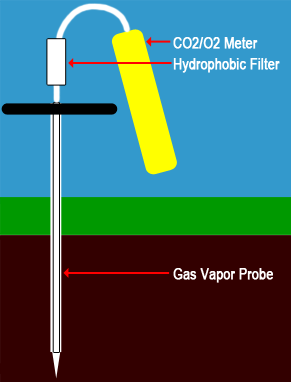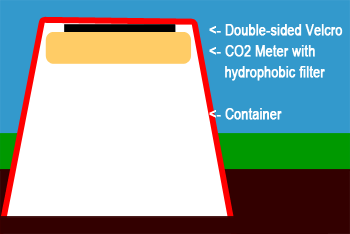Most of us who live in the city think of soil as “dirt.” However, soil is actually a living environment of underground plants, animals, and microorganisms that, like humans, need food, water and oxygen to survive.
Soil gas testing is the process of measuring oxygen, carbon dioxide, methane, radon, and other gases in soil. For example, large-scale composters monitor the gases inside long, narrow piles of plant material and manure called wind-rows. The right combination of moisture, temperature, oxygen and CO2 is required to feed the aerobic microbes that turn the materials into compost. Alternatively, biologists measure CO2 or methane gassing from fields or wetlands for long term environmental studies.
To measure compost or soil gas testing, here are 3 inexpensive solutions. Each of them rely on the fact that soil is porous, and over time the gas inside the tube will match the atmosphere in the soil.
 Gas Vapor Probe
Gas Vapor Probe
A Gas Vapor Probe provides the most scientific method for measuring soil gases. While you can purchase $2,500-$4,500 professional kits with an electric bore-hole drill that will reach virtually any depth, this $350 hand-held probe from AMS provides an inexpensive solution for shallow soil or compost pile testing. Either of these probes will work with our CO2+CH4 Sampling Data Logger or our CO2 Sampling Data Logger for soil gas testing. the built-in sampling pump will evacuate the tubing after a few seconds, and you can get an accurate measurement of the soil gas levels at the probe tip.
 Permanent Sampling Holes
Permanent Sampling Holes
For clients who need to monitor several soil gas stations over time, an inexpensive solution is to build your own monitoring station with PVC pipe. This station can be built for about $40 in parts. After the sampling hole is dug to the desired depth, a capped PVC pipe with a Locking Vapor Extraction Plug mounted to the top provides a low-cost, permanent station. With the vapor plug, you will not contaminate the gas inside the pipe with outdoor air. When you are ready to take a sample, attach the tubing, open the air lock, and take a reading with any of our hand-held sampling meters.
 Shallow Sampling Container
Shallow Sampling Container
For long-term data logging in shallow soil, you can use a 1% CO2 Data Logger mounted under a leak-proof container. Dig a hole to the desired depth, mount the data logger inside the container using double-sided Velcro, and bury the container in the hole securely. The 1% CO2 Data Logger with 6,000mAh Li-Ion batteries and the optional hydrophobic filter kit can record CO2, temperature and %RH levels for up to 6 months on a single charge.





 Gas Vapor Probe
Gas Vapor Probe Permanent Sampling Holes
Permanent Sampling Holes Shallow Sampling Container
Shallow Sampling Container
